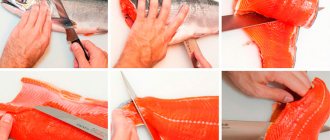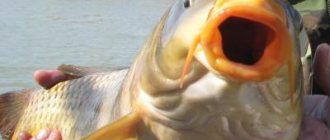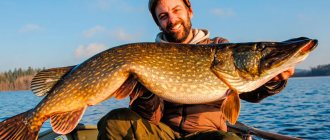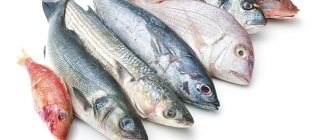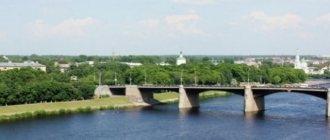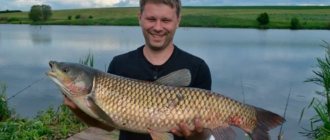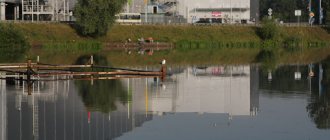Fishermen, for the most part, are creative and inquisitive people. Many people do not like to get hung up on certain and “familiar” places. They are driven by the search for new and unexplored territories, and sometimes the search for new species of fish that were previously rarely found in catches or were absent from them altogether.
Of course, finding new places may require a significant amount of time and expense, but what fisherman doesn’t dream of finding his secret spots?
It is reasonable to say that the best places can be found far from human settlements, where there is not much pressure. And on the way to such places, it’s worth trying to fish in any more or less suitable body of water.
But finding a promising river is only part of the task. It is important to be able to “read” the chosen body of water. Another famous classic L.P. Sabaneev said that the best fishing spots are in those areas that are noticeably distinguishable from the general background. There can be many such places on the river.
Overhanging trees
Overhanging Tree
In the heat of summer, areas of the river under overhanging trees can be a favorite habitat for most fish species. Taking refuge from the scorching sun, fish find here not only a resting place, but also abundant food. From the overhanging branches of bushes and trees, something edible constantly falls into the river. And this primarily attracts fish that prefer to feed from the surface: verkhovka, bleak, sabrefish, chub, medium-sized asp, etc.
Very often, trees growing at the water's edge fall into the water, forming a snag that serves as a place for additional shelter. In addition, fallen trees retain food brought by the current. A lot of small forage fish gather here, which in turn attracts predators such as pike and perch.
The disadvantage of such places may be difficulties in approaching the water's edge and some inconveniences during the fishing process. But additional bonuses will be the possibility of fishing in the shade and the comfortable arrangement of a cozy parking lot.
Water lilies and other underwater thickets
Thickets of water lilies are a
paradise for floaters and lovers of vertical fishing with a side nod. Such overgrown places are classic habitats for crucian carp and tench. But other fish also visit them: rudd, roach, ide, carp and even bream. Striped robbers and toothy pikes also love such places.
Thickets of water lilies and other aquatic plants provide good shelter for both predatory and peaceful fish. In addition, they provide shade, and fishing here is possible even on a hot summer day. Caddis flies, mayfly larvae and other aquatic insects readily settle in the thickets.
Fishing in the underwater jungle creates certain requirements for the fishing process. If there are no natural “windows”, then it makes sense to make such a gap yourself. And for catching pikes it is better to use non-snagging baits. It is also necessary to have sufficiently powerful gear for forced fishing of fish.
Other Important Aspects
The behavior of lake fish directly depends on the type of shores, because in almost all open reservoirs they are heavily overgrown with low or tall grass, bushes and trees.
Because of this, the angler finds himself in a limited space, which makes it difficult to cast gear accurately and far, especially when working with a spinning or feeder fishing rod. Regardless of size, all lakes are overgrown with vegetation. And a significant part of it is used by underwater inhabitants as a home or even a source of food. During the period of water blooms, the gills and stomach of the fish become clogged with small algae, which significantly impairs the functionality of the internal organs and even leads to the death of living organisms. When such a time comes, it is advisable to look for fish in areas with actively flowing underwater springs. If there is no bloom of water in the reservoir, then it is better to look for fish among the thickets of aquatic vegetation, throwing tackle into clearings and windows. In such areas the following inhabitants of the depths bite well:
- Tench.
- Pike.
- Bream.
- Rudd.
- Roach.
- Ide.
Under the influence of the sun, the glades among the algae heat up very intensely, so the water is abundantly saturated with oxygen. As soon as twilight comes and the process of photosynthesis stops, the inhabitants of the depths leave these areas and go into open space.
At the same time, the type of aquatic thickets varies, which also affects the behavior of the fish. For example, if we are talking about hard underwater vegetation, then it is of interest to underwater inhabitants only in the first month of summer. If the algae is soft, then they swim up to it and feed almost all summer. Plants such as reeds and sedges, which often cover coastal areas, can create a characteristic noise when exposed to the wind, which is why fish are afraid of them and run away. It's useless to fish here.
Read Fishing for grayling in different ways and choosing the best baits
Another very important factor for fishing on a lake is water temperature. In summer, water warms up very quickly in closed reservoirs, which creates a small layer of warm water at the surface of the water. At the same time, there is a noticeable difference in temperature and oxygen supply between it and the lower layer, so the fish begins to rapidly rise, looking for air and food.
https://youtube.com/watch?v=AEdL7iUjfDk
Holes near islands, on bends and in narrow places of rivers
Pits near an island
Any turn of the river or an island can indicate the possible presence of holes and whirlpools, sometimes very extended. Deep areas, as a rule, are the stopping place for trophy fish, especially predators. Most predatory fish strictly adhere to the principle of territoriality. They hunt within the boundaries of their territory, simultaneously protecting them from other individuals. It is clear that the best places are occupied by the largest and most seasoned specimens.
On river bends, pits are usually located on the outer bend, and on islands along the shore of a narrower branch or immediately behind the island, based on the direction of the current. The current speed there is noticeably lower, and often such places can be stuck. This may lead to some difficulties in the fishing process, but the possible capture of a trophy should not allow the fisherman to leave such areas unattended.
A weak current in places where the river narrows indicates the presence of great depth in this section. But even if the speed of the river there is the same as in the rest of its part, then there should still be channel edges where the fish will stay.
In addition to large specimens of catfish, pike and pike perch, it is worth trying to catch carp and bream in the pits. Other fish may also be caught.
Choosing a summer fishing spot
You can write and give examples ad infinitum about choosing a place for summer fishing on an unfamiliar river, lake, pond, reservoir, but I want to tell you only one, but the most important secret.
I still haven’t written anywhere about this method of choosing a site for fishing in the summer, and don’t tell anyone about it either, otherwise you’ll create an army of competitors.
There is one quick, time-tested way to determine a promising fishing spot on almost any unfamiliar body of water. For summer fishing, the method works flawlessly, and the fisherman should do so.
Looking carefully at the coastline, walk along the shore of a summer river, lake or pond and select the most trampled, spit-stained, cigarette butt-strewn area on the pond for fishing.
If in the bushes you find empty cans of canned food, scraps of paper, and old plastic bags from three years ago, then you have been fishing here many times over the years.
This means that, thanks to your extraordinary mind, you were lucky enough to choose a completely unknown place for summer fishing on a completely unfamiliar reservoir.
All that remains is to choose the right gear and summer hook baits suitable for fishing in your favorite area of the reservoir.
Otherwise, the catch will be zero, and my secret method of choosing a fishing spot on an unfamiliar body of water may not work. Good luck to you!
***
Similar topics of summer and winter fishing
Nods - guardhouses for summer and winter fishing
Read: What is the difference between bream and white bream in appearance and behavior?
Winter - summer jigs for fishing
Universal release for spinners and jigs
Confluences of other rivers and streams
Confluence of another river
The mouths of tributaries are the favorite habitat of most representatives of river inhabitants. Tributaries in their structure can differ markedly from the river into which they flow. This applies to many aspects, such as flow rate, degree of turbidity, temperature, oxygen balance, differences in chemical composition. In addition, tributaries can also contribute biological diversity due to the flow of their watercourses in other climatic and geographical zones. This is especially true for large tributaries.
All this gives rise to the possibility of catching a wide variety of fish in the changed structure of these areas. Sometimes such places can only be fished if you have swimming equipment. But if there are approaches to a promising point, then you can count on successful fishing when fishing from the shore. This applies to both lovers of fishing for peaceful fish and spinning anglers.
Often, alluvial sand spits form at the mouths of tributaries. At the beginning of these spits, as a rule, there are deep places with a reverse current, where you can try your hand at float fishing or fishing using various bottom rigs. Fishing at the end of the spit often allows you to reach the main channel dump.
Fishing in spring on the reservoir
In the spring, roach, ide, and bream accumulate at the mouths of rivers flowing into the reservoir, preparing to rise to the upper reaches to spawn. This is the time of melt waters, warm winds and good fishing during the rise of fish, which is called the spring run. Unlike small rivers, along which fish rise to the upper reaches to spawn in the spring, fishing in the vastness of the reservoir has its own very specific features. And at this time there are a lot of fish in the channels and on pit dumps along old river beds flooded by the reservoir, and you won’t be able to catch any fish. At this time, a ban on the entry of small vessels is introduced on most reservoirs. It is clear that you can row somewhere to the bushes on a fragile rubber boat, throw a fishing rod under the tautka standing in the water, and drag one after another roach, roach, bream, bream, since often in such places the fish are like in a cage . But even such seemingly innocent fishing can fall under the shout of a strict fish inspector. You can't fish from a boat at this time. That is, no matter how flimsy the vessel may be, even if it does not plan on the waves under the roaring Yamaha, it is impossible... Only from the shore.
Hydraulic structures. Breakwaters, bridges, dams
Promising places near the bridge
All artificially created hydraulic structures, one way or another, are one of the best places for fishing on any river.
They significantly change the character of the river, be it the speed of the flow, its direction, changes in the bottom topography, or even the hydraulic regime itself.
Such structures serve as excellent places for parking, resting, sheltering and feeding fish.
Breakwaters on rivers technically play the role of protecting the coastline from erosion by currents, and sometimes serve to prevent jamming of ice floes. Breakwaters adjacent to the shore are called moles, and those located separately in the water are called breakwaters.
Gravity dams, usually built on rivers, in addition to protecting against soil erosion, can also serve to regulate and straighten channels, and also improve the operation of culverts and water intake structures.
Both hydraulic structures are quite rare on rivers, but their presence can be a good place for fishing. During the warm months, peaceful fish rest here and actively feed. In mid-summer, schools of roach can eat filamentous algae, which abundantly grow on embankments. In turn, all this attracts different predators.
Bridges on rivers also cannot be ignored by the fisherman. Especially spinners. Under bridges, fish find shade and shelter, and often food that grows or develops on various river debris retained under the piles.
True, there are heated debates about the legal feasibility of fishing both under and from bridges. However, according to the letter of the law, it is, in principle, impossible to fish on any hydraulic structures, which, in theory, can even include a village man-made dam. So, fishing in such places is left to the discretion of the angler himself. In justification, we can only say that only hydroelectric dams and some water intake structures are really protected, which are impossible to get to even with a strong desire.
Factors influencing fishing on the lake
Weather
This factor manifests itself in all reservoirs. It has been noticed that always before the onset of bad weather, the fish begin to feed more actively and are better caught. This happens about a couple of hours before the onset of such a period and does not depend on the time of day.
The bite often improves with light rains that occur periodically. This happens even on days when strong winds blow. Fishing on the lake can be profitable in the first months of spring and late autumn when the weather warms up and the weather is sunny. In summer, on the contrary, cloudy days and calm winds are considered favorable for fishing.
Wind
A lake is always more open to the wind than a river. At least on the latter you can always find a place where it will be quieter, which is sometimes difficult to realize on the lake.
The effectiveness of fishing on the lake is greatly influenced by the direction of the wind, its strength and time of year. If its direction is from the south, southwest, west, then you can hope for successful fishing. When the wind brings cold air, which often happens in the off-season, the fish becomes passive and difficult to catch.
During the hot period, predators in the lake (pike, perch, pike perch) are inactive. But during the period of cool winds, when the temperature of the upper layers of water decreases, they become more active and are more often caught by fishermen. Carp, tench, crucian carp, on the contrary, are more active on warm days (especially in the morning and evening), and when it gets colder, which is brought by cold winds, they stop pecking.
The wind does not have the same effect on lakes, and therefore on the fishing conditions on them. If the reservoir is small, and even framed, for example, by a forest, then the water in it is mixed slowly by the wind. Large lakes get more - the water in them mixes continuously. All this affects the living conditions of the fish, and therefore the efficiency and stability of fishing.
Shores of the lake
In reality, almost all lakes have heavily overgrown shores. It can be low or tall grass, bushes, trees. All of them, as a rule, limit the space and complicate casting a fishing rod, working with a spinning rod, and a feeder.
Water temperature
This factor is also one of the most important for fishing on the lake. For example, in the summer, in the absence of wind, the water in the reservoir quickly heats up, creating a shallow layer of warm water at the top. At the same time, a clear boundary is maintained between it and the lower layer of cold water. The situation ends with the amount of oxygen in the water decreasing at depth, and because of this the fish begin to migrate to the surface, where there is more of it.
During such periods, deep fishing turns out to be completely ineffective. It is worth switching to fishing in the near-surface layers. And only after the wind appears, when it helps to mix the water in the lake, you can return to bottom fishing.
Seaweed
Almost all lakes, although in different ways, are overgrown with algae. Among the latter there are those that are used by underwater inhabitants for food and shelter; there are also those that they always avoid.
Read: Catching tench with a float rod
The period when the water in the lake begins to bloom is very unpleasant for fish. This leads to the clogging of their gills with small algae, which affects their life activity and can cause the death of underwater inhabitants. During flowering periods, fish are caught more in places where there are underwater springs.
In areas where water blooms are not observed, fish (tench, pike, bream, rudd, roach, ide) during the day should be looked for among algae (in clearings, windows), which, under the influence of sunlight, saturate the water with oxygen. With the onset of darkness, when photosynthesis stops, the fish leave the thickets and fishing in such areas will be fruitless.
Thickets in the lake water can be different. For example, if it is hard underwater vegetation, then it is attractive to fish only in the first month of summer. If the algae is soft, then the fish visit or settle in their thickets throughout the summer season.
Sedges and reeds, which often grow in the coastal waters of lakes, always make noise under the influence of even a weak wind. This noise usually alarms or frightens the fish - lake fishing in such areas often ends in nothing.
Freeze-up
Ice formation on small and shallow lakes always occurs earlier than on rivers
Due to this, winter fishing begins earlier on them, which is important for fishermen who like to fish from ice
Other promising fishing spots on the river
In fact, any section of the river, even one that is completely unremarkable at first glance, can become a real discovery for the fisherman. For example, many fish can be found on straight, canal-like sections. Spinners who practice running fishing or those who like to fish with feeder gear, who lure fish with abundant and not so much feeding, are well aware of this. Typically, fish in the river do not stand in one place and make constant migrations in search of feeding grounds. It is only important that this area has an uneven bottom structure. This can be determined visually by the change in color of the water. Sometimes, the reasons for the catchability of such places may lie in the presence of underwater formations invisible to the eye.
Roll
Other interesting places can be riffles, which are often unreasonably ignored by some anglers. They may be of particular interest to spinners. Also, rifts can be recommended for adherents of fly fishing and lovers of wire fishing. Despite the relative general shallowness and rapidity of the current, the rifts are replete with various water barriers, such as large stones or sediments, behind which there is a vacuum zone. There, fish can wait for their victims, who strive to quickly overcome these areas or intercept food brought by the current. Riffles are the favorite habitats of chub, asp, trout, grayling, dace, and less commonly pike, roach and the ubiquitous perch. The disadvantage of such places is usually the need for wading fishing. Although in the heat, why not?
Thus, fishing on the river allows you not only to hone your skills in using various fishing methods, but also to significantly expand your fishing and research horizons. And the new river will definitely be an opportunity to enjoy the beauty of a previously unknown area.

